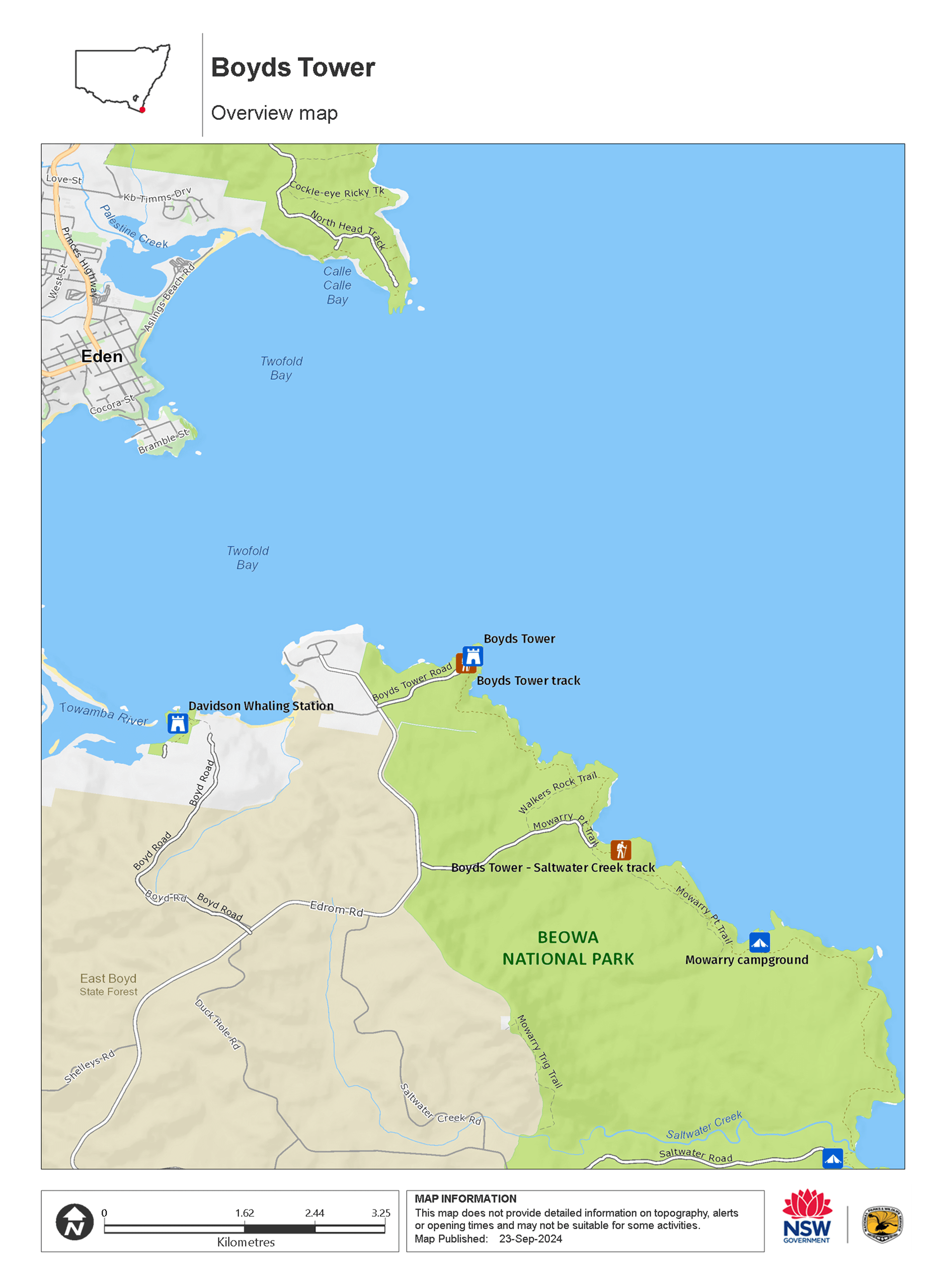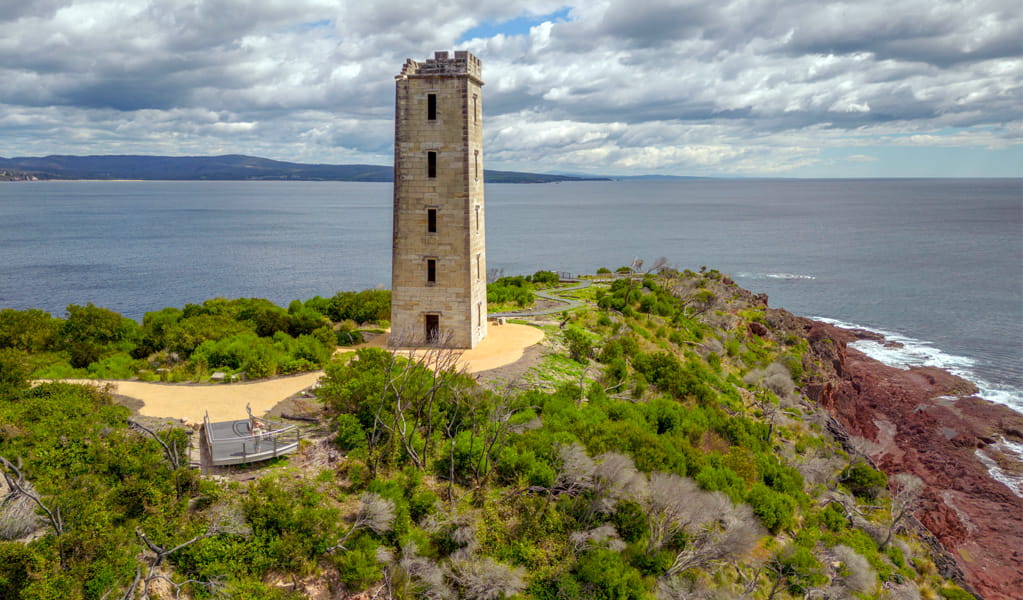Boyds Tower
Green Cape area in Beowa National Park
Overview
Boyds Tower is the starting point of the Light to Light walk. Near Eden, this accessible landmark tells the story of Benjamin Boyd who built the tower in 1847. Visit for some of the best whale watching on the NSW south coast.
- Type
- Historic buildings/places
- Where
- Boyds Tower Road, Edrom, NSW, 2551 - in Green Cape area in Beowa National Park in South Coast
- Accessibility
- Easy
- Entry fees
-
$8 per vehicle per day in the Green Cape area of the park (south of Eden).
- What to
bring - Binoculars, clothes for all weather conditions, hat, sturdy shoes, sunscreen, drinking water
Benjamin Boyd built Boyds Tower of expensive Pyrmont sandstone as a symbol of his power, intending it to be a lighthouse but the government did not approve. Boyd went bankrupt soon after and fled to California, abandoning his debts and workers.
The tower became a whale spotting platform for the whaling industry until the 1920s, then fell into disuse with the internal stairs and flooring now rotted away. You can see where the tower was struck by lightning and Boyd’s name inscribed on the parapet.
Take the wheelchair-accessible boardwalk to the lookout for beautiful views of Twofold Bay and its red cliffs. Remember your binoculars as you can see humpback and southern right whales on their migration between April and November. Commercial whaling nearly killed them all—now an estimated 50,000 swim past each season due to conservation efforts. You might also spot dolphins, fur seals and even little penguins.
If historic buildings are your thing, drive to nearby Davidson Whaling Station or Green Cape Lighthouse.
Nearby
Map

Map legend

Local alerts
For the latest updates on fires, closures and other alerts in this area, see https://www.nationalparks.nsw.gov.au/things-to-do/historic-buildings-places/boyds-tower/local-alerts
General enquiries
- National Parks Contact Centre
- 7am to 7pm daily
- 1300 072 757 (13000 PARKS) for the cost of a local call within Australia excluding mobiles
- parks.info@environment.nsw.gov.au
Park info
- in the Green Cape area of Beowa National Park in the South Coast region
The Green Cape area of Beowa National Park is always open but may have to close at times due to poor weather or fire danger.
-
$8 per vehicle per day in the Green Cape area of the park (south of Eden).
Buy annual pass.
Visitor info
All the practical information you need to know about Boyds Tower.
Getting there and parking
Boyds Tower is in the southern section of Beowa National Park near Eden. To get there:
- Travel south from Eden on Princes Highway for 18km, then turn left onto Edrom Road
- About 15km along Edrom Road, turn right onto Boyds Tower Road.
- Drive 1.5km to Boyds Tower.
Road quality
- Mixture of sealed and unsealed roads
Vehicle access
- 2WD vehicles
Weather restrictions
- All weather
Parking
There's a gravel car park with space for 22 vehicles, including 1 accessible parking space.
By bike
Cycling is permitted on the public access roads
Facilities
Toilets
There is an accessible non-flush toilet
- Non-flush toilets
Carpark
The carpark has 22 spaces. One space is accessible.Step-free access
- Very gentle slopes, so assistance should not be needed
- The walk to the tower is a 350m hard packed gravel track.
- A boardwalk continues behind the tower to a viewing platform
- Step-free outdoor pathways
Seats and resting points
There's a seat at the viewing platform where you can rest and look north over Twofold Bay.
Maps and downloads
Accessibility
Disability access level - easy
- The site is fully accessible. It's free of obstacles such as steps, rough terrain or significant slopes.
- There is a 350m wheelchair-accessible hard packed gravel track to the tower.
- A wheelchair-accessible boardwalk continues behind the tower to a viewing platform with a seat, looking north over Twofold Bay.
Permitted
Fishing
A current NSW recreational fishing licence is required when fishing in all waters.
Prohibited
Pets
Pets and domestic animals (other than certified assistance animals) are not permitted. Find out which regional parks allow dog walking and see the pets in parks policy for more information.
Smoking
NSW national parks are no smoking areas.
Learn more
Boyds Tower is in Green Cape area. Here are just some of the reasons why this park is special:
Aboriginal culture

The Yuin People are the Traditional Owners and Custodians of Beowa National Park and they have a long and complex relationship with the coastal environment. At Twofold Bay, the Yuin People had a special relationship with the orca whales. The orcas drove humpback whales into shore, the people used spears to kill them and the orcas and people shared the meat. Aboriginal people later taught European settlers to work with orca whales during the shore-based whaling days of Twofold Bay.
- Boyds Tower walking track Take an easy walk to historic Boyds Tower near Eden, find out about local history and marine animals, and enjoy whale watching from the lookouts.
Giants of the deep

Enjoy some of Australia’s best whale watching here between September and November when hundreds of whales and their calves move in to Twofold Bay to frolic and feed before migrating south to Antarctica. You can get a good view of Twofold Bay from the viewing platform at Boyds Tower. At the southern tip of the park, see if you can spot whales near Green Cape Lightstation or Disaster Bay lookout.
- Green Cape lookout Green Cape lookout in Beowa National Park is one of the best places to enjoy whale watching in NSW.
Rocks tell a story

Beowa’s stunning rock formations, inlets and headlands are the result of extensive geological folding. Most of the park lies on red, brown and green shales, sandstones, siltstones and quartzites. They were formed in the Devonian period around 360 million years ago—before dinosaurs roamed the earth. You can see these rock types exposed along the cliffs and headlands. The Devonian period is known as The Age of Fishes and internationally-significant fish fossils have been found in several places along the park’s coastline.
- Guided 3-day Light to Light walks Join the experienced local guides of Sapphire Coast Guiding Co and make the most of one of the best treks on the Far South Coast, in Beowa National Park near Eden.
- Light to Light walk Begin this multi-day walk at Boyds Tower down the far south coast, and end at Green Cape Lighthouse. Stop for a swim and the opportunity to spot seals, seabirds and whales.
Vulnerable species

The heathland in the Green Cape area of the park provides significant habitat for vulnerable species like the eastern ground parrot and striated fieldwren. It’s also a stronghold for NSW’s population of the endangered southern brown bandicoot. Around 50 native mammals and nearly 150 species of birds have been recorded in Beowa National Park, including 1 critically endangered bird, 4 endangered animal species and 25 vulnerable species.
- Boyds Tower Boyds Tower is the starting point of the Light to Light walk. Near Eden, this accessible landmark tells the story of Benjamin Boyd who built the tower in 1847. Visit for some of the best whale watching on the NSW south coast.
- Boyds Tower walking track Take an easy walk to historic Boyds Tower near Eden, find out about local history and marine animals, and enjoy whale watching from the lookouts.
- Guided 3-day Light to Light walks Join the experienced local guides of Sapphire Coast Guiding Co and make the most of one of the best treks on the Far South Coast, in Beowa National Park near Eden.
- Light to Light walk Begin this multi-day walk at Boyds Tower down the far south coast, and end at Green Cape Lighthouse. Stop for a swim and the opportunity to spot seals, seabirds and whales.
Fascinating coastal heritage

The first shore-based whaling station on mainland Australia was set up at Twofold Bay in 1828. Benjamin Boyd established a competing business and built a private lighthouse, Boyd's Tower, and a township, Boydtown, before being declared bankrupt. The coast was the site of many shipwrecks. Green Cape Lighthstation started operation in 1883 but shipwrecks continued, including the Ly-ee-moon that sank in 1886. You can pay your respects to some of the 76 victims at a graveyard a short walk from the lighthouse. There are also regular guided tours of the lighthouse.
- Boyds Tower Boyds Tower is the starting point of the Light to Light walk. Near Eden, this accessible landmark tells the story of Benjamin Boyd who built the tower in 1847. Visit for some of the best whale watching on the NSW south coast.
- Boyds Tower walking track Take an easy walk to historic Boyds Tower near Eden, find out about local history and marine animals, and enjoy whale watching from the lookouts.
- Green Cape Lighthouse guided tour Uncover the history of Green Cape Lighthouse on this guided tour in Beowa National Park, near Eden. Hear stories of disaster and survival and enjoy shore-based whale watching and breathtaking views.
Plants and animals protected in this park
Animals
-

Yellow-tailed black cockatoo (Calyptorhynchus funereus)
The yellow-tailed black cockatoo is one of the largest species of parrot. With dusty-black plumage, they have a yellow tail and cheek patch. They’re easily spotted while bird watching, as they feed on seeds in native forests and pine plantations.
-

White-bellied sea eagle (Haliaeetus leucogaster)
White-bellied sea eagles can be easily identified by their white tail and dark grey wings. These raptors are often spotted cruising the coastal breezes throughout Australia, and make for some scenic bird watching. Powerful Australian birds of prey, they are known to mate for life, and return each year to the same nest to breed.
-

Superb lyrebird (Menura novaehollandiae)
With a complex mimicking call and an elaborate courtship dance to match, the superb lyrebird is one of the most spectacular Australian animals. A bird watching must-see, the superb lyrebird can be found in rainforests and wet woodlands across eastern NSW and Victoria.
-

Eastern ground parrot (Pezoporus wallicus wallicus)
The eastern ground parrot is a beautiful, ground-dwelling native bird that lives in low heathland habitat along the NSW North and South coasts and escarpments. It’s listed as a vulnerable species in NSW.
-

Lace monitor (Varanus varius)
One of Australia’s largest lizards, the carnivorous tree-dwelling lace monitor, or tree goanna, can grow to 2m in length and is found in forests and coastal tablelands across eastern Australia. These Australian animals are typically dark blue in colour with whitish spots or blotches.
Plants
-

Black sheoak (Allocasuarina littoralis)
The black sheoak is one of a number of casuarina species found across the east coast of Australia and nearby tablelands. Growing to a height of 5-15m, these hardy Australian native plants can survive in poor or sandy soils. The barrel-shaped cone of the black sheoak grows to 10-30mm long.
-

Grey mangrove (Avicennia marina)
Grey mangrove is the most common and widespread mangrove found within intertidal zones across Australia, and throughout the world. Growing to a height of 3-10m, they thrive best in estuaries with a mix of fresh and salt water. They excrete excess salt through their long thick leaves, and absorb oxygen through their aerial root system.
-

Old man banksia (Banksia serrata)
Hardy Australian native plants, old man banksias can be found along the coast, and in the dry sclerophyll forests and sandstone mountain ranges of NSW. With roughened bark and gnarled limbs, they produce a distinctive cylindrical yellow-green banksia flower which blossoms from summer to early autumn.







